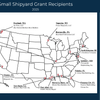While the theoretical jury deciding which direction the offshore drilling market will take is still out, recent data suggests that the level of spending internationally will disappoint. Calling a 10.2 percent gain in spending may seem a bit harsh, particularly given the depths to which the market has sunken in the previous two years. But considering that the price per barrel has catapulted from the $10 level early in 1999 to the mid-20's by the beginning of 2000, it is fair to say that expectations were set a bit higher. According to a recent Lehman Brothers survey, the following are the spending plans, by world region, for more than 320 oil companies.
The silver lining to the above numbers, of course, is the level of increase expected in North America. But despite these advances — there are still noticeable reservations regarding activity levels — reservations being the result of many factors. First, the energy markets have been through —and continue to — embark on a trail toward historic levels of consolidation. It is still undefined as to how fewer, larger companies will deploy their E&P dollars. Second, the actions of the member of OPEC are still in question. Oil pricing gains are largely the result of output cutbacks. While the organization appears more committed than ever to maintaining a profitable supply and demand balance, there are no guarantees that the market won't be flooded with new reserves at any given moment. For example, countries with poorly performing economies or who weather severe natural disasters may be enticed to increase output to fill budget gaps.
While offshore players seemingly expected the bounce back to be delayed until mid-year, following naturally industry tendencies, it is fair to say that offshore rig and service providers and their investors are itching to start locking up contracts again.
Sponsored Content
Safer Starts Here: Build Ships, Protect Crews

Featured videos

Cat Pushes Forward on Hybrid Electric Solutions, Alternative Fuels

Corn Belt Ports Streamlines Critical Agriculture River Shipments

“One Man, One Wrench” Launched a Global Maritime Power Play
July 2025
 Read the Magazine
Read the Magazine

 Read the Magazine
Read the Magazine
This issue sponsored by:

Precision in Motion – Inside American Fan’s Mission to Support the U.S. Navy Fleet
Subscribe for
Maritime Reporter E-News
Maritime Reporter E-News is the maritime industry's largest circulation and most authoritative ENews Service, delivered to your Email five times per week







